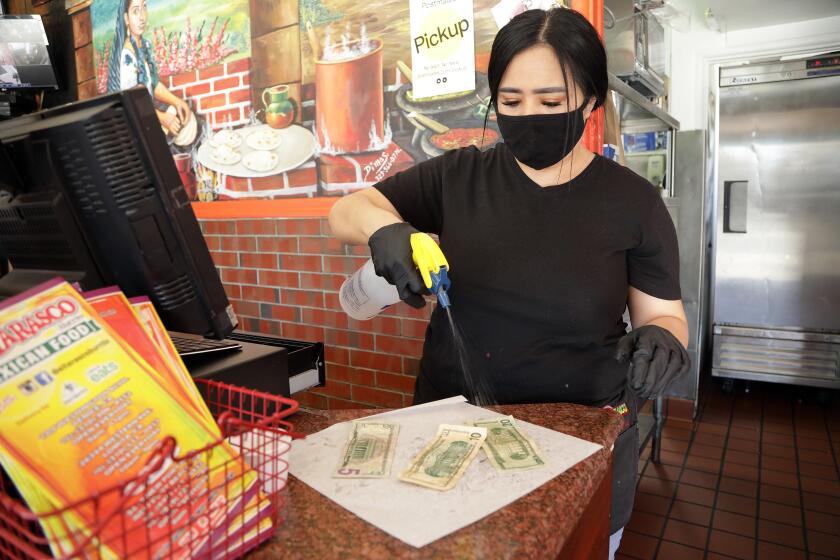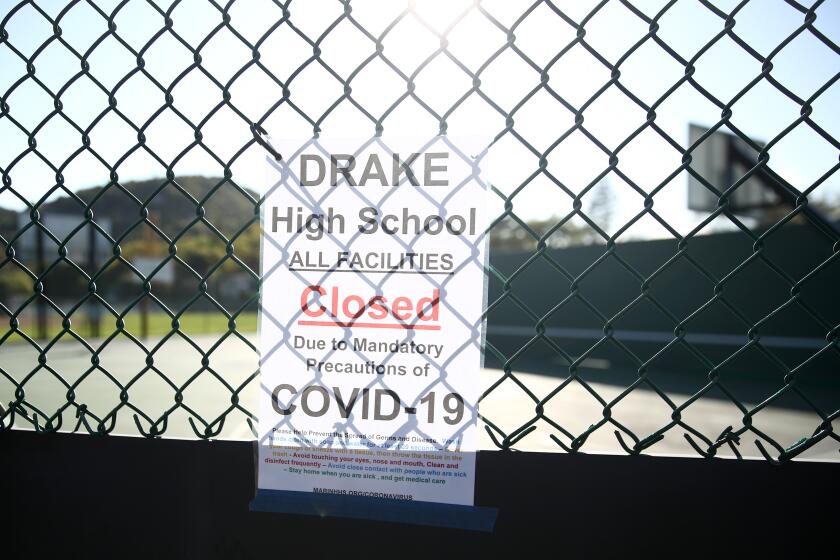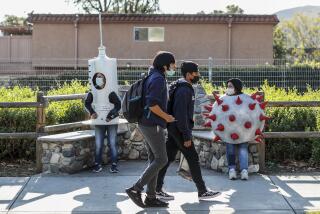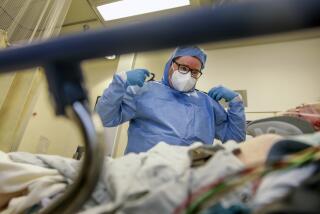California could see 5,000 coronavirus deaths a week if social distancing eases too soon
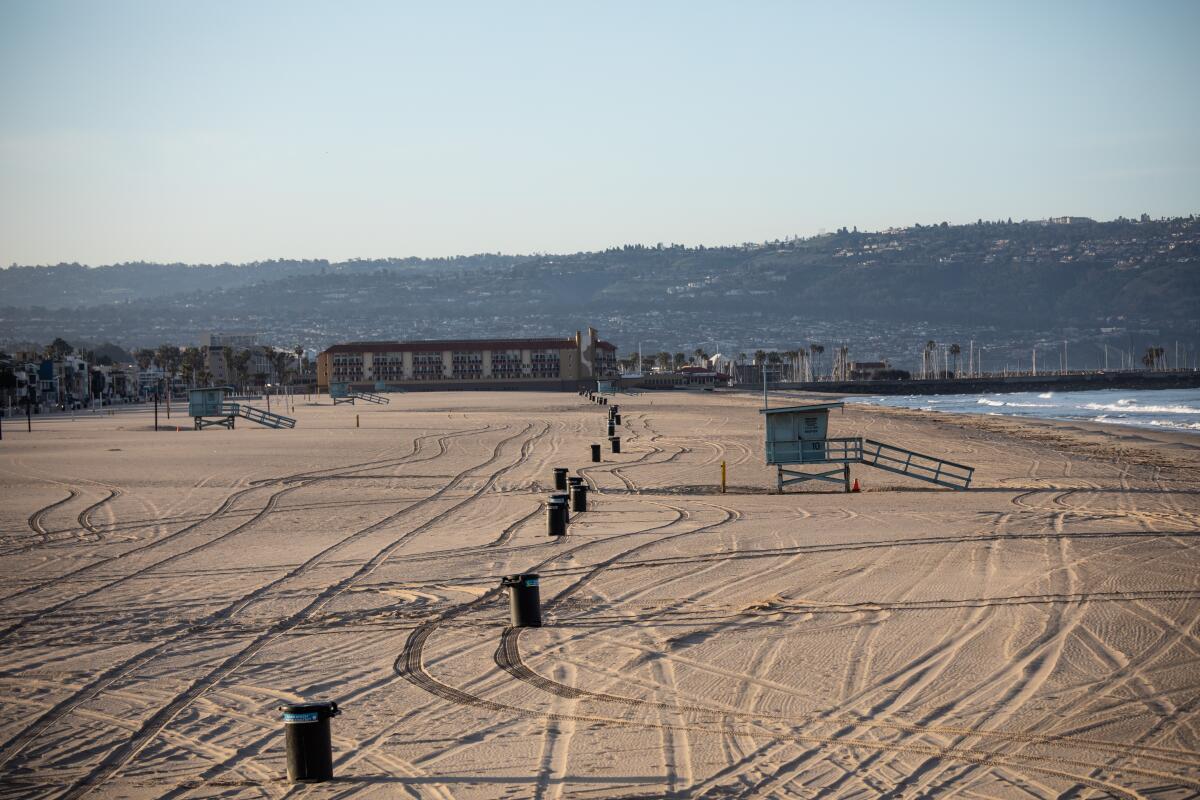
- Share via
MILLBRAE, Calif. — California faces 5,000 coronavirus deaths a week if the state’s stay-at-home policies are relaxed too early, a health officer in the Bay Area said Tuesday.
“Some of the modeling is predicting — at the peak — up to 5,000 deaths a week throughout California,” Dr. Chris Farnitano, health officer for Contra Costa County, told his Board of Supervisors. That would mean 600 deaths a week from the disease known as COVID-19 in the central San Francisco Bay Area, and 100 to 200 deaths a week in Contra Costa County, he said.
“We are still hopeful we can avoid [this scenario] if we don’t relax our efforts to flatten the curve,” said Farnitano, who shared the possible epidemic outcomes on the same day that six Bay Area counties extended and strengthened the nation’s first coronavirus shelter-in-place order.
The news came as local health officials began revealing estimates of potential coronavirus death tolls in various counties Tuesday. There could be 2,000 to 14,000 deaths in Contra Costa County, and perhaps 1,000 deaths in Ventura County, health officers for both counties said. Last week, the city of San Jose released an estimate saying there could be 2,000 to 16,000 coronavirus deaths in Santa Clara County.
Dr. Robert Levin, health officer for Ventura County, said the number of coronavirus cases coming into hospitals could be a tsunami. In the last 21 years he’s been tracking the data, the worst year for flu deaths came two years ago, with 49 fatalities — a small fraction of the 1,000 deaths the coronavirus could bring to Ventura County.
“This is not influenza. This is much more serious,” Levin said at a Board of Supervisors meeting Tuesday. But he added that he hopes the stay-at-home order will significantly curtail the projected death toll.
There are promising signs for Contra Costa County, a suburban county northeast of Oakland with 1.2 million residents.
There are some early signs that new hospital cases of coronavirus are slowing, and that’s important. If hospital cases double every six days, Contra Costa County could start running out of beds by late April, around the time coronavirus cases are expected to be the most intense.
Right now, hospital cases are doubling about every eight days.
If the county is able to slow the doubling to every 10 days, “we might have enough hospital beds to handle the surge,” Farnitano said. The worst period for coronavirus cases is expected between mid-April and mid-May, he said.
Los Angeles Times’ visual coverage of the coronavirus crisis
The estimate of 2,000 to 14,000 deaths in Contra Costa County, Farnitano said, “is based on the number of cases we have and how effective our social distancing is going to be.”
The number is similar to a projected death toll for Silicon Valley that San Jose officials released last week. San Jose Deputy City Manager Kip Harkness said 2,000 to 16,000 people could die from the virus by the end of May in Santa Clara County, which has a population of nearly 2 million. Santa Clara County officials released a statement that the model presented by the city was not vetted by the county.
Signs the shelter-in-place order is working
Some health officers in California said there are early signs that the shelter-in-place order is working. Farnitano noted that California’s coronavirus death toll has been about 10% of New York’s.
“Now we’re seeing terrible outbreaks in New Orleans and Detroit and Chicago,” Farnitano said. “So it’s really important: This is not the time to relax. These kinds of scenarios could still happen in the Bay Area if we relax our social distancing.”
Farnitano said in his county, public transit ridership was down 80% to 90%, and miles traveled by residents had been cut in half.
The Santa Clara County health officer, Dr. Sara Cody, said Tuesday that she is seeing a bit of slowing in the number of COVID-19 cases, although she added that she was speaking cautiously.
“The sacrifice that everyone has made, I believe it is starting to bend the curve. But it’s not enough, and it hasn’t been in place for long enough,” Cody said at a news conference. “So we need to keep at it. We just need to keep at it. I believe it’s beginning to make a difference, and it’s giving our hospitals more time.”
Coronavirus: As deaths across California rise, stay-home orders and school closures are extended and state prisons grant 3,500 early releases.
Short on supplies
The extra time is essential. Some hospitals are reporting shortages of staff and safety equipment needed to prepare for the surge in patients.
In San Mateo County, south of San Francisco, officials sounded the alarm over a lack of personal protective equipment for Seton Medical Center in Daly City. The state of California recently leased 177 beds from Seton to treat COVID-19 patients, but officials said Tuesday that the state doesn’t seem to have a plan to secure critical safety gear for the hospital in San Mateo County’s most populous city.
A Bay Area hospital desperately need supplies, including masks
“Here’s what I see: I see a disaster on the brink of happening,” San Mateo County Supervisor David Canepa said. “Us not hearing from the state is problematic. Because we don’t have the resources — the hospital can only acquire 20% of what they need — we could have the potential of having all these COVID patients and no PPE [personal protective equipment].”
Contra Costa County was short on gowns, with only 1,000 left in its central supply, and no estimate when a resupply would arrive, Farnitano said. Medical-grade cleaning supplies, wipes and face shields were also limited.
Testing delays still problematic
Testing delays are still problematic. In Contra Costa County, officials said results that once took seven to 10 days can still take four to five days, Farnitano said. There are also shortages of chemicals needed to process the tests and supplies to collect samples from patients.
Coronavirus testing is an essential part of slowing the spread. From swab to result, follow along with one very sick patient’s test.
On Monday, the San Francisco director of public health, Dr. Grant Colfax, said his public health lab was expecting to triple its potential capacity to process tests by Tuesday. But the city was still struggling to get swabs needed for tests as well as the processing chemicals needed to generate test results.
“Our supply chains are episodic and hard to determine,” Colfax said.
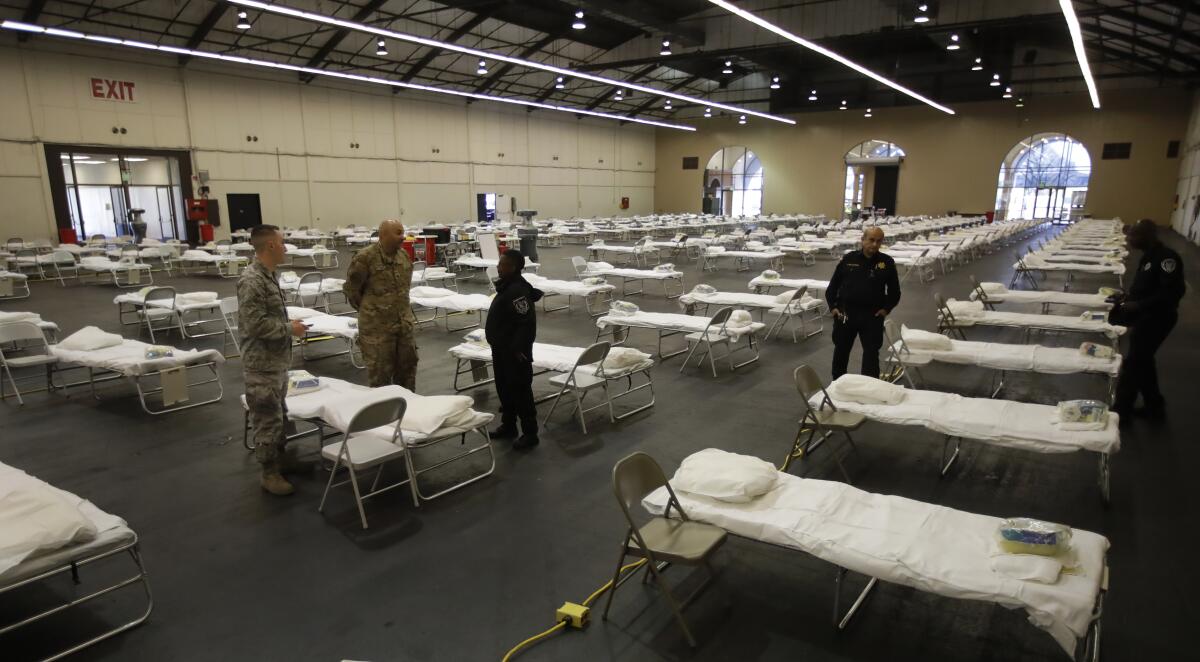
Hospitals not full yet
Health and government officials said hospitals were not yet at capacity.
In the 11 hospitals in Santa Clara County, as of Monday, out of an available 611 ventilators, 209 were being used Tuesday, and 500 more were expected soon.
Out of about 300 intensive care unit beds in Santa Clara County, 119 were still available Monday. Of those being occupied, 56 were being used by COVID-19 patients.
In San Mateo County, there were just five free intensive care unit beds out of 66.
Ventura County, which has 1,200 to 1,300 hospital beds, may need the ability to care for 2,500 people and maybe more, Levin said. “It’s better for us to overdo it, to have too much capacity, than to have too little,” he said.
Dr. Jeffrey Smith, the Santa Clara County executive — who is also a doctor and a lawyer — said that capacity in a hospital system can flex in a crisis, up to a certain point.
“It’s not like filling a glass of water, where you get to the top, and it overflows,” Smith said. “It’s more like filling up a water balloon, where there’s some flexibility ... so it’s not like you’re going to reach a capacity, and then you’re done. But at some point, the water balloon does break.
“So our job right now is to get as many resources and as many ventilators and as much space in the hospital and health system as much as possible,” Smith said.
Tricky issues
And there are still tricky issues that county officials are trying to sort out — like where to place COVID-19 patients who no longer need hospitalization but still require the kind of care a nursing home or long-term care facility could provide.
In San Mateo County, Louise Rogers, chief of San Mateo County Health, said at a meeting Tuesday that she was hoping the county, state and the U.S. Centers for Disease Control and Prevention can figure out a way to return COVID-19 patients to nursing homes if they no longer need to be hospitalized. San Mateo County’s hospitals don’t have the capacity to hold those patients, she said.
Coronavirus outbreaks are occurring in nursing homes at terrifying speed. The elderly are among the most vulnerable to the deadly new pathogen.
In Ventura County, Levin said he wanted to keep COVID-19 patients out of long-term care facilities, and that was being made possible by preparations the county’s hospitals are taking.
He also warned he might have trouble meeting that goal.
“We may have to go to skilled nursing facilities or extended-care facilities and ask them for a wing so that we can use it to dedicate and cohort patients with COVID, so that we keep them out of the rest of the [skilled nursing facilities] and extended-care facilities,” Levin said.
More to Read
Sign up for Essential California
The most important California stories and recommendations in your inbox every morning.
You may occasionally receive promotional content from the Los Angeles Times.
